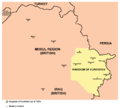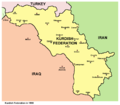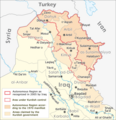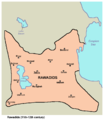Dinastie e stati curdi
Vai alla navigazione
Vai alla ricerca
Questa voce elenca le dinastie, gli stati e i territori autonomi curdi. Nel X secolo, il termine "curdo" non aveva una connotazione etnica e si riferiva ai nomadi iranici nella regione tra il lago di Van e il lago di Urmia.[1] Nelle fonti medievali arabe, "curdo" si riferiva a nomadi e semi-nomadi non persiani e non turchi.[2][3]
Prime entità[modifica | modifica wikitesto]

- Sadaqiya (770-827)
- Daysam (938-955)[4]
- Hadhabani (906-1080)
- Aishanidi (912-961)[5]
- Shaddadidi (951-1199)[6]
- Rawadidi (955-1071)[7]
- Hasanwayhidi (959-1014)[8]
- Marwanidi (983-1096)[6]
- Annazidi (990/991[8][9]-1117)[10]
- Shabankara (XI secolo-XII secolo)[11][12]
- Principato di Eğil (1049-1864, Diyarbakir)[13]
- Hazaraspidi (1115-1425)
- Dinastia ayyubide (1171-1341)[14]
- Principato di Bitlis (1187-1847)
- Ardalan (XIV secolo[15]-1865 o 1868)[16][17]
- Zakaridi (1161-1360)[18][19][20]
- Emirato di Çemişgezek (XIII secolo-1663)[21]
- Mukriyan (XIV secolo-XIX secolo)[22]
- Dinastia Zarrinnaal (1448-1925)
- Emirato di Pazooka (1499–1587)[23]
- Principato di Suleyman[24] (XV secolo-1838)
- Emirato di Soran (prima del 1514[25]-1836)[26]
- Emirato di Miks (? -1846)[27]
Resti della Dinastia Ayyubide (XIII-XIX secolo)[modifica | modifica wikitesto]
Nel periodo successivo alla dissoluzione della dinastia ayyubide, nel 1260 fiorirono varie entità politiche curde. Alcuni di questi governatori sostenevano di discendere dagli Ayyubidi.
- Principato di Donboli (1210-1799)[28]
- Emirato di Bingöl (1231-1864)[29]
- Emirato di Hasankeyf (1232[29]-1524[29])
- Emirato di Kilis[30]
- Emirato di Şirvan (? -anni 1840)[31]
- Emirato di Hakkâri (?-1845)[32]
- Principato di Zirqan (1335-1835)
- Emirato di Bahdinan (1339[33]-1843)
- Emirato di Bohtan (?–1833)[34]
- Principato di Mahmudi (1406-1839)[35]
- Principato di Pinyaşi (1548-1823)[36]
Zone cuscinetto tra gli Ottomani e la Persia (XIII-XIX secolo)[modifica | modifica wikitesto]
Per varie ragioni, nel corso della storia le entità curde esistettero come zone cuscinetto tra l'Impero ottomano e la Persia. Queste entità includevano:
- Khanato di Khoy (1210-1799)
- Emirato di Palu (1495-1845)[37]
- Emirato di Bradost (1510-1609)[38]
- Baban (XVI secolo-1850)[39]
- Khanato di Tabriz (1757-1799)[40]
- Dinastia Hasan Khan a Pish-e Kuh (1795-1820)[41]
- Khanato di Sarab (XVIII secolo)[40]
Altre dinastie di origine curda[modifica | modifica wikitesto]
- Dinastia Safavide (1501-1736) - La dinastia era in parte di origine curda.[42][43][44]
- Dinastia Zand (1751-1794) - La dinastia era di origine curda lak.[45][46]
Entità del XX-XXI secolo[modifica | modifica wikitesto]
- Stato curdo (1918-1919)
- Regno del Kurdistan (1921-1924 e 1925)
- Uezd del Kurdistan(1923-1929) e Okrug del Kurdistan (1930)
- Repubblica di Ararat (1927-1931)
- Repubblica di Mahabad (1946-1947)
- Repubblica di Laçin (1992)[47]
- Emirato islamico di Byara (2001-2003)
-
Disposizioni del Trattato di Sèvres per un Kurdistan indipendente (nel 1920)
-
Regno del Kurdistan (1923)
-
Kurdistan rosso (1923-1929)
-
Repubblica di Mahabad, (1945-1946)
-
Emirato islamico di Byara (nero) al loro apice, che controlla l'intero Governatorato di Halabja
Entità attuali[modifica | modifica wikitesto]
- Regione del Kurdistan (regione autonoma in Iraq, 1970-oggi)
- Amministrazione autonoma della Siria del Nord-Est (regione autoproclamata autonoma dichiarata durante la guerra civile siriana dal PYD ) (2012-oggi)
-
Kurdistan iracheno nel 1975
-
Kurdistan iracheno nel 1998
-
Kurdistan iracheno nel 2012
-
Kurdistan iracheno moderno
Galleria d'immagini[modifica | modifica wikitesto]
-
Exclave curda Khurasani intorno al 1835
-
Dinastia Rawadid
Note[modifica | modifica wikitesto]
- ^ (EN) Martin van Bruinessen, The ethnic identity of the Kurds, in Peter A. Andrews (ed.), Ethnic groups in the Republic of Turkey, pp. 613-21, 1º gennaio 1989.
- ^ (EN) John Limbert, The Origins and Appearance of the Kurds in Pre-Islamic Iran, in Iranian Studies, vol. 1, n. 2, 1968, pp. 41–51, DOI:10.1080/00210866808701350.
- ^ (EN) James, Boris, Uses and Values of the Term Kurd in Arabic Medieval Literary Sources, su Institutkurde.org.
- ^ (EN) Bosworth, Daysam, su iranicaonline.org, 1994.
- ^ Tor, D.G. (2017). The Abbasid and Carolingian Empires: Studies in Civilizational Formation. Brill Academic Pub. pp. 54-55.
- ^ a b (EN) Amir Hassanpour, Nationalism and Language in Kurdistan, 1918-1985, Mellen Research University Press, 1992, p. 50, ISBN 978-0-7734-9816-7.
- ^ Peacock, 2017
- ^ a b Gunter, 2010, p. 117.
- ^ (EN) Pezeshk, Manouchehr; Negahban, Farzin, ʿAnnāzids, su referenceworks.brillonline.com, In Madelung, Wilferd; Daftary, Farhad (eds.). Encyclopaedia Islamica Online. Brill Online. ISSN 1875-9831., 2008.
- ^ Ahmad, K. M., ʿANNAZIDS, su iranicaonline.org, 1985.
- ^ Büchner, 2012
- ^ Spuler, 2012
- ^ Han, Şeref (Çev. İbrahim Sunkur), Şerefname : Kürt tarihi, 2016, p. 204, ISBN 978-605-66520-1-1, OCLC 984148348.
- ^ R. S. Humphreys, Ayyubids, "Encyclopaedia Iranica"
- ^ Oberling, P., BANĪ ARDALĀN, su iranicaonline.org.
- ^ David Mcdowall, The Kurds (PDF), su bnk.institutkurde.org, Minority Rights Group International Report, p. 20.
- ^ (FR) Najat Abdulla-Ali (2006). Empire, frontière et tribu Le Kurdistan et le conflit de frontière turco-persan (1843-1932) p. 159.
- ^ Alexei Lidov, 1991, The mural paintings of Akhtala, p. 14, Nauka Publishers, Central Dept. of Oriental Literature, University of Michigan, ISBN, ISBN, It is clear from the account of these Armenian historians that Ivane's great grandfather broke away from the Kurdish tribe of Babir
- ^ Vladimir Minorsky, 1953, Studies in Caucasian History, p. 102, CUP Archive, ISBN, ISBN, According to a tradition which has every reason to be true, their ancestors were Mesopotamian Kurds of the tribe (xel) Babirakan.
- ^ Richard Barrie Dobson, 2000, Encyclopedia of the Middle Ages: A-J, p. 107, Editions du Cerf, University of Michigan, ISBN, ISBN, under the Christianized Kurdish dynasty of Zak'arids they tried to re-establish nazarar system...
- ^ Ünal, 1999, pp. 262-263.
- ^ Hassanpour, Amir, BŪKĀN, su iranicaonline.org, 1989.
- ^ Han, Şeref (Çev. İbrahim Sunkur), Şerefname : Kürt tarihi, 2016, p. 375, ISBN 978-605-66520-1-1, OCLC 984148348.
- ^ Houtsma, 1993, pp. 1444-1445.
- ^ Ghalib, 2011, p. 50.
- ^ Ebraheem, 2013, p. 235.
- ^ Hakan, 2002
- ^ Başçı, 2019, p. 63.
- ^ a b c Maisel, 2018, p. 131.
- ^ Soyudoğan, 2015
- ^ Verheij, 2018
- ^ Flynn, 2017, p. 663.
- ^ Aboona, 2008, p. 175.
- ^ Eppel, 2018, p. 42.
- ^ Top, 1999, pp. 6, 9.
- ^ Kaplan, 2015, p. 4.
- ^ Nusret Aydın, Diyarbakır and Mirdasiler History, 2011, p. 304-305
- ^ Dehqan, Genç, 2019
- ^ Behn, 1988
- ^ a b Tapper, Richard, Shahsevan, su iranicaonline.org, 2010.
- ^ (EN) Mustafa Dehqan, Arkawāzī and His Baweyaļ : A Feylî Elegiac Verse from Piştiku, in Iranian Studies, vol. 42, n. 3, 2009-06, pp. 409–422, DOI:10.1080/00210860902907362.
- ^ Matthee, 2005, p. 17.Matthee, 2008.
- ^ Amoretti, Matthle, 2009
- ^ Savory, 2008, p. 8.
- ^ Perry, John, Zand Dinasty, su iranicaonline.org, p. 616.«The founder of the dynasty was Moḥammad Karim Khan b. Ināq Khan (...) of the Bagala branch of the Zand, a pastoral tribe of the Lak branch of Lors (perhaps originally Kurds; see Minorsky»
- ^ (EN) William Bayne Fisher, P. Avery e Ilya Gershevitch, The Cambridge History of Iran, Cambridge University Press, 1968, p. 64, ISBN 978-0-521-20095-0.
- ^ (EN) Michael Kemper e Stephan Conermann, The Heritage of Soviet Oriental Studies, Routledge, 2011-02, p. 92, ISBN 978-1-136-83854-5.«In 1992 the area of Laçin was occupied by Armeian forces; a "Kurdish Republic of Laçin" was subsequently declared by local Kurds, but this remained a rather short-lived - not to say stillborn - adventure»
Bibliografia[modifica | modifica wikitesto]
- (EN) Hirmis Aboona, Assyrians, Kurds, and Ottomans : intercommunal relations on the periphery of the Ottoman Empire, Cambria Press, 2008, ISBN 978-1-62499-167-7, OCLC 819325565.
- (EN) Rudolph P. Matthee, The Pursuit of Pleasure: Drugs and Stimulants in Iranian History, 1500-1900, Princeton University Press, 2005, ISBN 978-0-691-11855-0.
- (EN) Matthee, Rudi, SAFAVID DYNASTY, su iranicaonline.org, 2008.
- (EN) Savory, Roger, EBN BAZZĀZ, su iranicaonline.org, 2008.
- (TR) Başçı, Veysel, Dunbulî Beyliği Tarihi ve Tarihi Kronikleri [XIII-XVIII. YY.], su dergipark.org.tr, Kadim Akademi SBD, 2019.
- (EN) Behn, W., BĀBĀN, vol. 3, Encyclopedia Iranica, 1988.
- (EN) Büchner, V. F., S̲H̲ABĀNKĀRA, Koninklijke Brill NV, DOI:10.1163/2214-871x_ei1_sim_5253.
- (EN) Mustafa Dehqan e Vural Genç, The Kurdish Emirate of Brādōst, 1510-1609 (XML), in Oriente Moderno, vol. 99, n. 3, 7 ottobre 2019, pp. 306–320, DOI:10.1163/22138617-12340222.
- (EN) Ebraheem, Sharameen, The Impact of Architectural Identity on Nation Branding: The Case Study of Iraqi Kurdistan (PDF), su e-space.mmu.ac.uk, Manchester Metropolitan University's Research Repository, 2013.
- (EN) Michael Eppel, The Kurdish emirates, 1ª ed., Routledge, 6 agosto 2018, pp. 35–47, DOI:10.4324/9781315627427-4, ISBN 978-1-315-62742-7.
- (EN) Thomas S. R. O Flynn, The Western Christian presence in the Russias and Q?aj?ar Persia, c. 1760-c. 1870, 2017, ISBN 90-04-31354-0, OCLC 1024177243.
- (EN) Ghalib, Sabah Abdullah, The Emergence of Kurdism with Special Reference to the Three Kurdish Emirates within the Ottoman Empire, 1800-1850, su ore.exeter.ac.uk, University of Exeter, 2011.
- (EN) Michael M. Gunter, Historical dictionary of the Kurds, 2nd ed, Scarecrow Press, 2011, ISBN 978-0-8108-6751-2, OCLC 643081902.
- (TR) Sinan Hakan, Müküs Kürt mirleri tarihi ve Han Mahmud, 1 baskı, Pêrı̂ Yayınları, 2002, ISBN 975-8245-58-9, OCLC 54096437.
- (EN) Houtsma, M. Th., First Encyclopaedia of Islam: 1913-1936, BRILL, 1993, ISBN 978-90-04-09796-4.
- (TR) Yasar Kaplan, Pınyanış Hükümeti/Government of Pinyanish, in Uluslararası Tarihte Hakkâri Sempozyumu Bildiriler Kitabı, 17-19 Ekim 2015, s. 477-518, 1º gennaio 2015.
- (EN) Sebastian Maisel, The Kurds : an encyclopedia of life, culture, and society, 2018, ISBN 978-1-4408-4257-3, OCLC 1031040153.
- (EN) Michael Meinecke, Patterns of stylistic changes in Islamic architecture : local traditions versus migrating artists, New York University Press, 1996, ISBN 0-8147-5492-9, OCLC 31971633.
- (EN) Soyudoğan, Muhsin, Tribal Bandistry in Ottoman Ayntab (1690-1730) (PDF), su core.ac.uk, Bilkent University, 2015.
- (EN) Spuler, B., FADLAWAYH, Koninklijke Brill NV, DOI:10.1163/1573-3912_islam_sim_2233.
- (TR) Mehmet Top, Hoşap'taki Mahmudi Beylerine Ait Mimari Eserler.
- (EN) Jelle Verheij, “The year of the firman:” The 1895 massacres in Hizan and Şirvan (Bitlis vilayet), in Études arméniennes contemporaines, n. 10, 30 marzo 2018, pp. 125–159, DOI:10.4000/eac.1495.
- (TR) Mehmet Ali Ünal, XVI. yüzyılda Çemişgezek sancağı, Türk Tarih Kurumu Basımevi, 1999, ISBN 978-975-16-0957-1.
- (EN) Peacock, Andrew, RAWWADIDS, su iranicaonline.org, Encyclopædia Iranica, 2017.











